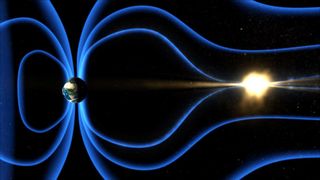
(Image credit: Courtesy of NASA/Goddard Space Flight Center-Conceptual Image Lab)
You may not know this, but Earth’s magnetic field has a tail. As the sun’s solar wind buffets the planet, it leaves behind a sort of long shadow that trails out in our planet’s wake. Scientists call this magnetic tail, appropriately, the magnetotail. Typically, the magnetotail is strewn with magnetic storms.
But for the past several years, scientists have known of a mystery in the magnetotail: a missing storm. They have found a signature of a storm, but no storm to actually go along with it. NASA’s Magnetospheric Multiscale (MMS) mission is now on the case.
MMS consists of four satellites that all launched on the same Atlas V rocket in 2015. Since then, the quartet has been studying Earth’s magnetopause: the frontier of the region dominated by the planet’s magnetic field. The magnetopause is constantly aflame with magnetic reconnections, which refer to when the lines that make up a magnetic field come together, break apart, then rejoin, creating brilliant flurries of heat and kinetic energy. (These reconnections, if they happen in Earth’s atmosphere, can cause auroras.)
Related: 4 NASA Satellites to Seek Energy Eruptions in Earth’s Magnetic Field
Scientists call these flurries substorms. In 2017, MMS spotted the trademark magnetic reconnection of a substorm — but no actual substorm to go along with it. A substorm should come with violent electric currents and magnetic field fluctuations, but MMS spotted traces of neither.
“We have not looked at the movement of the magnetic field lines on a global scale, so it could be that this unusual substorm was a very localized occurrence that MMS happened to observe,” said Andy Marshall, a postdoc at the Southwest Research Institute, in a statement. “If not, it could reshape our understanding of the relationship between tail-side reconnection and substorms.”
So, for the next year, MMS will measure the magnetic reconnections in Earth’s real magnetic field, while scientists on the ground conduct simulations of the magnetic field to understand how it behaves. By comparing the two, scientists hope they can solve the mystery by better understanding the precise relationship between reconnection and the events they cause.
Breaking space news, the latest updates on rocket launches, skywatching events and more!
“It’s possible that significant differences exist between the global magnetotail convection patterns for substorms and non-substorm tail reconnection,” Marshall said.
Join our Space Forums to keep talking space on the latest missions, night sky and more! And if you have a news tip, correction or comment, let us know at: [email protected].
Rahul Rao is a graduate of New York University’s SHERP and a freelance science writer, regularly covering physics, space, and infrastructure. His work has appeared in Gizmodo, Popular Science, Inverse, IEEE Spectrum, and Continuum. He enjoys riding trains for fun, and he has seen every surviving episode of Doctor Who. He holds a masters degree in science writing from New York University’s Science, Health and Environmental Reporting Program (SHERP) and earned a bachelors degree from Vanderbilt University, where he studied English and physics.
>>> Read full article>>>
Copyright for syndicated content belongs to the linked Source : Space.com – https://www.space.com/mms-magnetic-substorms































